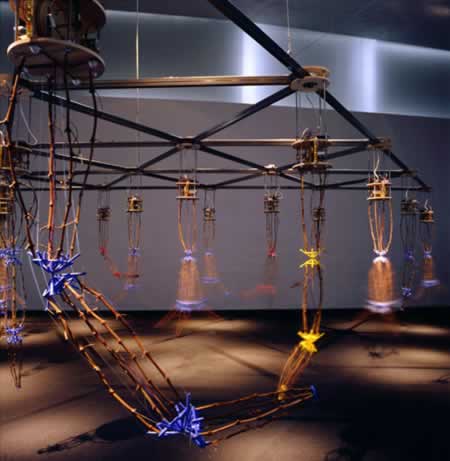"My interdisciplinary media art installations look to the intersection between natural and technological systems. Integration of the organic and electro-mechanical elements asserts a confluence and co-evolution between living and evolving technological material. I am fascinated and encouraged with human kinds struggle to evolve technological systems that move toward intelligence and autonomy which are modeled from our current conceptions of the natural. My art works are influenced by theories on living systems, artificial life, interspecies communication and the underlying beauty and pattern inherent in the nature and organization of matter, energy, and information. While I find hope and fascination with our techno-cultural evolution, many of my works express concern for ecological issues, which are often not considered within the realm of technological and cultural progress.
[...] The branching and joining of physical forms in my work echoes the behavioral flow and multiple directions an interactive piece may take in the act of self-organizing. I am compelled by open structures that define form but do not close the form off to the viewer. I use exposed electronics and mechanics as part of the aesthetic in proposing structural relationships between wire, circuits and natural structures. I believe it is imperative that technological systems acknowledge and model the evolved wisdom of natural living systems, so they will inherently fuse, to permit an emergent and interdependent earth. Symbio - technoetic can describe this philosophy."
(http://accad.osu.edu/~rinaldo/)
The term autopoiesis was originally introduced by Chilean biologists Humberto Maturana and Francisco Varela in 1973:
- "An autopoietic machine is a machine organized (defined as a unity) as a network of processes of production (transformation and destruction) of components which: (i) through their interactions and transformations continuously regenerate and realize the network of processes (relations) that produced them; and (ii) constitute it (the machine) as a concrete unity in space in which they (the components) exist by specifying the topological domain of its realization as such a network." (Maturana, Varela, 1980, p. 78)
- "[…] the space defined by an autopoietic system is self-contained and cannot be described by using dimensions that define another space. When we refer to our interactions with a concrete autopoietic system, however, we project this system on the space of our manipulations and make a description of this projection." (Maturana, Varela, 1980, p. 89)
The term autopoiesis was originally conceived as an attempt to characterize the nature of living systems. More generally, the notion of autopoiesis is often associated with that of self-organization; an autopoietic system is characterised as being: autonomous and operationally closed, in the sense that every process within it directly helps maintaining the whole. Medium and system are structurally coupled together in a continuous dynamic exchange, which can be considered as knowledge. (compare with Luhmann's Systems Theory).
(shortened from the wikipedia-entry)





No comments:
Post a Comment